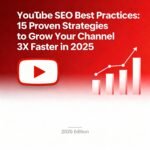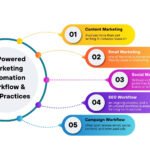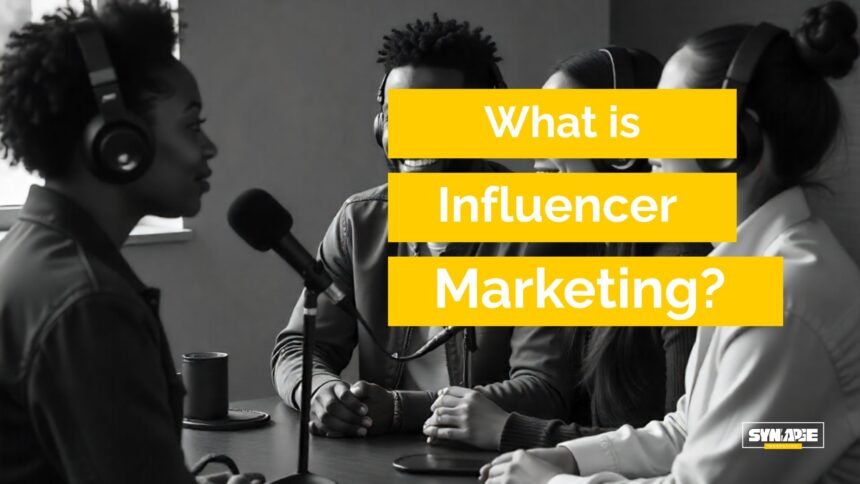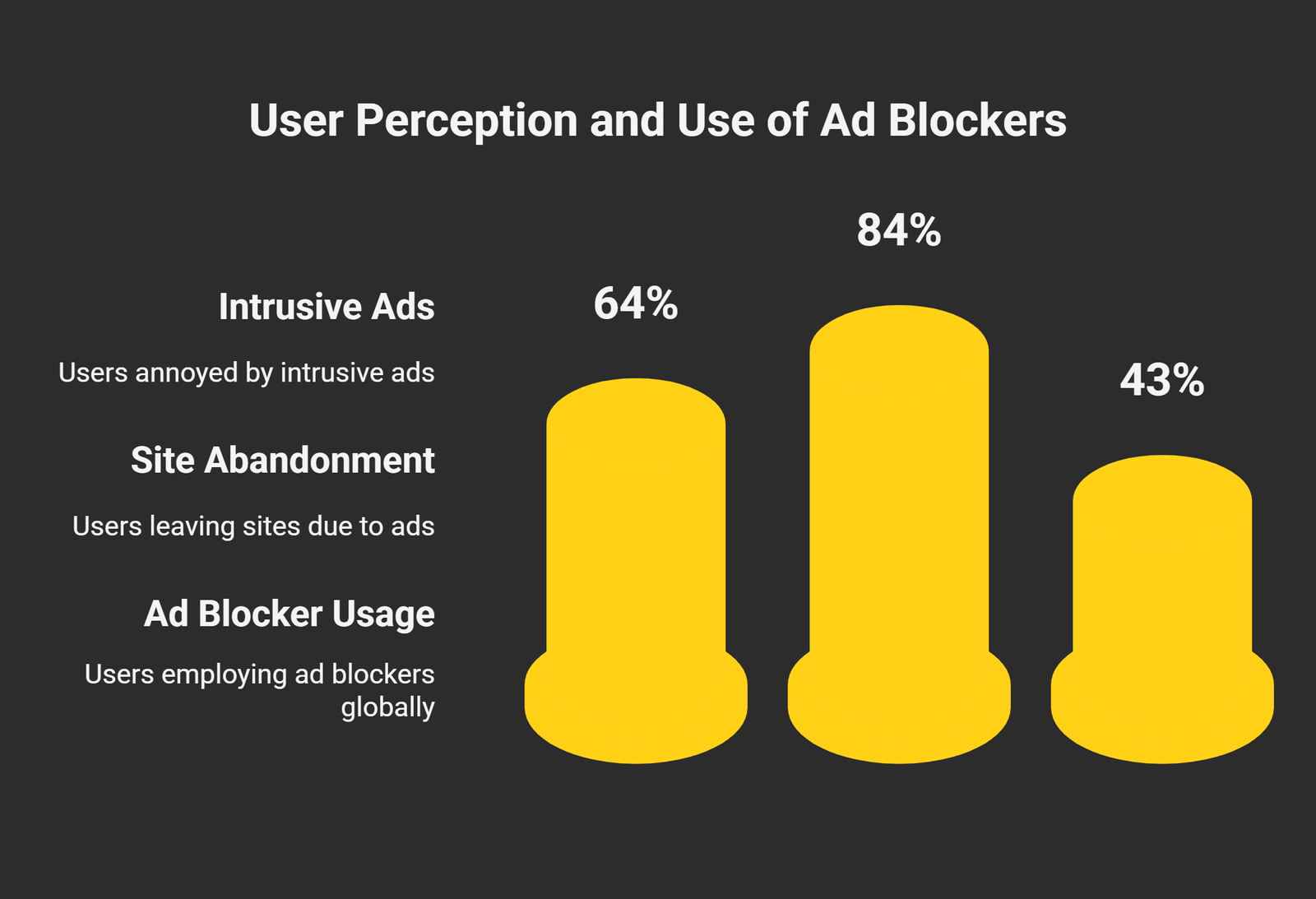Welcome to the attention economy—where brand loyalty is built not by billboards, but by people with a ring light, a smartphone, and a fiercely engaged following. If you’ve ever bought a skincare product because your favorite YouTuber raved about it, or tried a new restaurant after a glowing TikTok review, you’ve already seen influencer marketing in action.
And you’re not alone. A staggering 93% of marketers now incorporate influencer marketing into their overall strategy (Influencer Marketing Hub, 2025). Why? Because traditional advertising is fading into the background noise, while influencer content is commanding center stage—and driving real results.
So, what is influencer marketing—and why does it matter now more than ever?
This guide breaks it all down:
- What influencer marketing really is (beyond paid shoutouts)
- Why it works in today’s trust-driven, algorithm-fueled digital landscape
- How brands are using it to drive engagement, conversions, and brand equity
Whether you’re a startup founder, a content creator, or a seasoned CMO, understanding influencer marketing isn’t optional anymore—it’s foundational to thriving in a social-first, authenticity-obsessed era.
Let’s unpack the strategy behind the buzz, explore the data behind the hype, and answer the big question every brand is asking: What is Influencer Marketing?
What is Influencer Marketing?
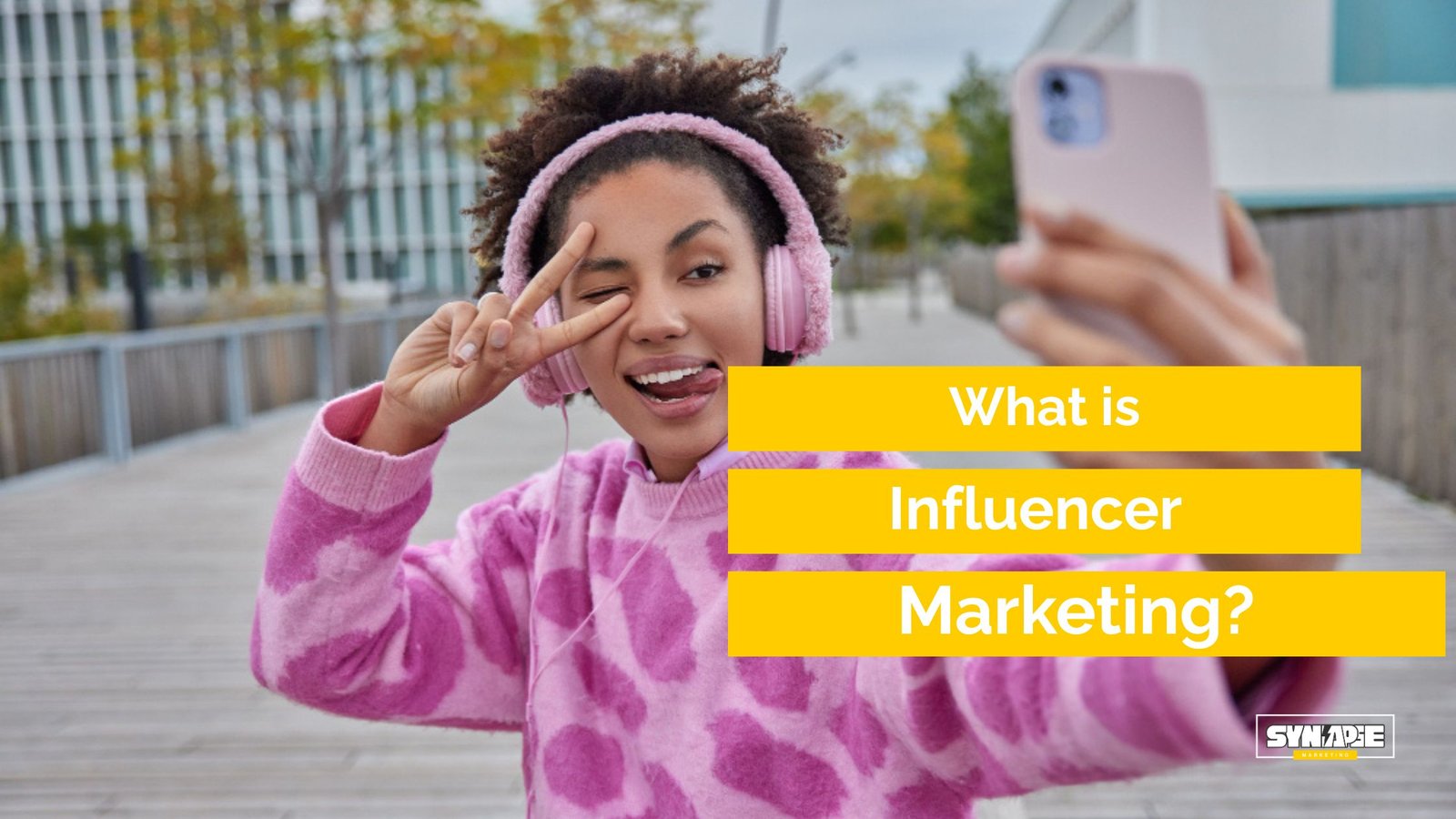
Influencer marketing is the modern evolution of word-of-mouth—only now, it happens at scale, through curated feeds, viral stories, and personal recommendations from creators you trust more than any brand billboard. At its core, influencer marketing is a strategic partnership between a brand and an individual who has built authority and trust with an engaged audience on platforms like Instagram, YouTube, TikTok, and LinkedIn.
These individuals—known as social media influencers or content creators—use their platforms to endorse products, tell stories, and connect brands with the exact niche audiences they want to reach. The key difference from traditional ads? Authenticity. Influencer content doesn’t feel like advertising—it feels like a recommendation from a friend.
According to a 2025 report by McKinsey, 61% of consumers trust influencers’ product reviews more than branded content or celebrity endorsements. That stat alone shows the psychological shift: consumers no longer buy from faceless companies—they buy from people they believe.
Let’s break it down:
- A brand identifies a content creator or digital marketing influencer whose followers reflect their target audience.
- The influencer integrates the product or service into their content—often via sponsored posts, story reviews, or video features.
- The result? A blend of storytelling, social proof, and trusted recommendations that drive visibility, clicks, and conversions.
In short, if you’re asking what is influencer marketing, it’s this:
A high-trust, high-impact way to promote your brand through the voices your audience already listens to.
But this isn’t just about flashy collaborations or viral dances—it’s a carefully orchestrated form of niche marketing, shaped by data, creativity, and strategy. And when done right, it delivers measurable returns.
Here’s what powers its success:
- High audience engagement from people who’ve opted in to follow and interact
- Authentic product placement that fits naturally into the influencer’s daily content
- Amplified reach across channels where consumers spend most of their time
In a digital era where attention is currency, influencer marketing is one of the smartest investments a brand can make.
How Influencer Marketing Works
To understand the power behind influencer marketing, you need to see the machinery under the hood. It’s not just about sending free products to a popular TikToker and hoping for the best. Effective influencer campaigns are grounded in strategy, audience alignment, and performance tracking—all wrapped in content that feels organic, not forced.
Here’s how influencer marketing typically unfolds from start to finish:
1: Identifying the Right Influencer
This is where it all begins. Brands use tools like Upfluence, AspireIQ, or even Instagram’s native analytics to find creators whose audience demographics, engagement rate, and content style match their target audience. Whether it’s a micro-influencer in the skincare niche or a macro fitness influencer, the key is relevance—not just reach.
According to Influencer Marketing Hub (2025), campaigns that prioritize audience relevance over follower count achieve 2.5x better ROI.
2: Defining Campaign Goals and Content Type
Before any content goes live, the brand and influencer align on goals:
- Are you driving sales?
- Looking to boost brand awareness?
- Trying to promote a new product launch?
Once the objective is locked, the influencer decides how to best deliver it—through a sponsored Instagram post, a YouTube review, a TikTok trend, or a blog feature. Authenticity is everything. A pushy product plug will flop. A seamless integration? That converts.
3: Content Creation and Collaboration
Influencers produce sponsored content tailored to their voice and audience, ensuring the message feels personal—not corporate. This might include:
- Unboxing videos
- Product demos
- Behind-the-scenes usage
- Subtle mentions in daily routines
The beauty? Influencer partnerships often yield more than just a shoutout—they deliver high-quality content creator marketing assets that can be repurposed across paid ads, email campaigns, and social feeds.
4: Campaign Launch and Amplification
Once content goes live, it’s all about audience engagement. The best campaigns spark comments, shares, saves, and DMs—all of which are metrics that feed algorithms and extend organic reach.
Pro Tip: Many brands now use whitelisting—running paid ads through the influencer’s account—to further amplify content visibility. This blend of organic and paid performance is known as hybrid influencer marketing.
5: Tracking Performance and Measuring ROI
Modern tools like CreatorIQ and GRIN track:
- Engagement rate (likes + comments ÷ followers)
- Click-through rates (CTR)
- Conversion data (sales, sign-ups, downloads)
- Audience growth during the campaign
“While Salesforce doesn’t confirm this exact number, Salesforce‑associated sources show strong ROI—e.g., 299% ROI over three years from Marketing Cloud investments. Other industry benchmarks show influencer campaigns consistently yield $5.78 to $6.50 earned media value per $1 spent across platforms (LinkedIn, Salesforce, Medium, 2025).”
Influencer marketing works because it bridges credibility and conversion. It replaces ad fatigue with storytelling, banner blindness with emotional resonance, and passive impressions with real influence.
So if you’re still asking what is influencer marketing, here’s your answer again—it’s the strategic use of influential voices to build brand trust, drive action, and cut through digital noise.
Types of Influencers and Their Impact
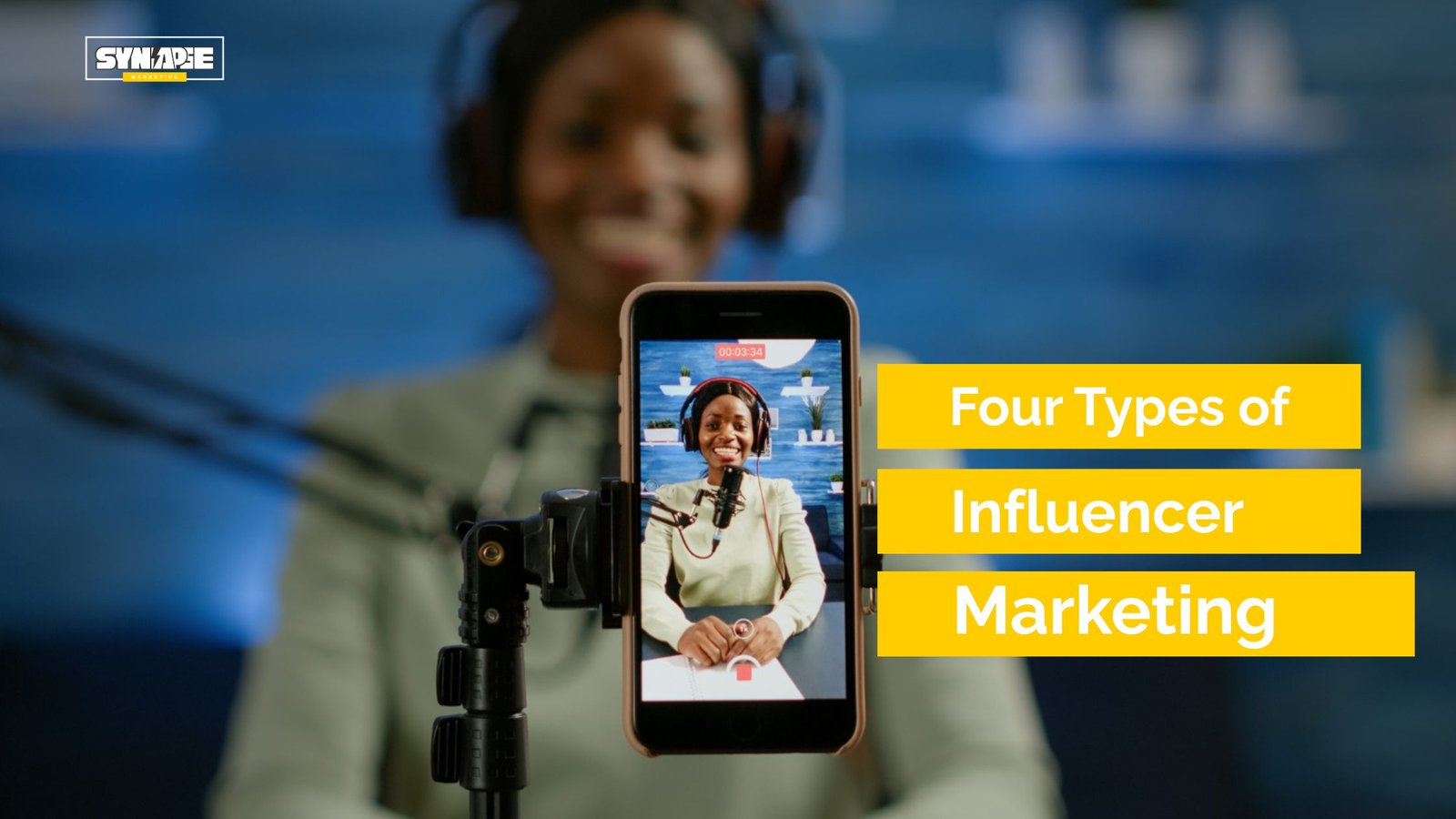
Not all influencers are created equal—and that’s a good thing. The influencer ecosystem is diverse, and understanding the tiers is key to selecting the right voices for your brand. Whether you’re launching a mass-market product or targeting a hyper-specific niche, there’s an influencer tier tailored to your campaign goals.
Let’s unpack the four primary types of influencers—based on follower count, content style, and audience engagement—and what each brings to the table.
1. Mega-Influencers
Followers: 1M+
Examples: Celebrities, internet-famous personalities, global trendsetters
Mega-influencers bring unmatched visibility. Their reach spans millions, often across multiple platforms—making them ideal for global brand promotion campaigns. However, this broad appeal comes with a price tag: high fees, lower engagement rates, and less niche relevance.
Best for: Big-budget brands looking to make a splash, launch-wide awareness, or boost credibility through star power.
2. Macro-Influencers
Followers: 100K–1M
Examples: Professional content creators, niche-famous personalities
Macro-influencers hit the sweet spot between reach and relatability. Their content is polished, their voice established, and their audience still engaged. They excel at storytelling, long-form reviews, and influencer campaigns that demand depth and authority.
Stat: “Studies show that micro-influencers can convert at ~20% higher rates than macro influencers, and nano tiers can achieve up to a 7% conversion rate—roughly 2× more than macro-tier performance (StackInfluence, 2025).”
Best for: Mid-to-large brands needing strong reach, trust, and influencer marketing strategy alignment.
3. Micro-Influencers
Followers: 10K–100K
Examples: Experts in fashion, wellness, finance, tech, parenting, etc.
This is where niche marketing shines. Micro-influencers have cultivated tight-knit communities built on authenticity. Their recommendations feel less like advertising and more like advice from a trusted friend.
- Higher engagement rates (often between 3%–6%)
- Lower cost-per-post
- Deeper audience trust
Stat: “Multiple sources confirm that micro‑influencers consistently deliver approximately 60% more engagement than macro‑ or mega‑influencers—a trend shown across platforms like Instagram and TikTok (JoinBrands, SocialTargeter, 2025).”
Best for: DTC brands, startups, local businesses, and companies with limited budgets seeking meaningful conversions.
4. Nano-Influencers
Followers: Under 10K
Examples: Everyday people with loyal, highly engaged audiences
Don’t let the follower count fool you—nano-influencers are the underdogs of influencer partnerships. Their influence is often local, deeply personal, and fiercely trusted. They’re perfect for hyper-targeted, grassroots campaigns.
Stat: “Nano-influencers often achieve execution rates between 4%–8%—significantly higher than other tiers—especially in beauty, food, and lifestyle verticals (Influencer Marketing Hub and industry data, 2025).”
Best for: Local launches, product endorsements, affiliate-style promotions, and community-led growth strategies.
Matching Influencer Types to Your Brand Goals
| Brand Objective | Best Influencer Type |
| Brand awareness | Mega or Macro |
| Community engagement | Micro or Nano |
| Lead generation | Micro or Macro |
| Niche product marketing | Micro or Nano |
| International brand growth | Mega |
Choosing the right influencer isn’t just about who has the biggest following—it’s about resonance, reach, and relevance. The most successful influencer campaigns are born at the intersection of audience insight, platform strategy, and creator authenticity.
So, whether you’re scaling a global campaign or launching locally, understanding these tiers will help you answer a critical part of the bigger question: What is Influencer Marketing—and how do I make it work for my brand?
Influencer Marketing vs. Traditional Advertising
Traditional advertising still has its place—but let’s not pretend the landscape hasn’t shifted. Between banner blindness, ad-blockers, and shrinking TV audiences, consumer trust in conventional advertising is at an all-time low. On the other hand, influencer marketing is thriving—precisely because it feels real, not rehearsed.
So what separates the two? Everything from delivery to audience engagement to ROI.
Traditional Advertising: One-Way, One-Size-Fits-All
TV commercials, radio spots, print ads, and display banners all fall into this category. While they offer scale and control, they suffer from lack of personalization and declining trust.
Challenges:
- High production costs
- Low targeting precision
- Passive consumption
- Minimal trust factor
- Increasing ad fatigue
Stat: “According to HubSpot and Adblock Plus research, 64% of internet users find ads intrusive and 84% have left a site because of them. Additional data shows 43% of global users use ad blockers on at least one device.”
Influencer Marketing: Conversational, Targeted, Trusted
This model flips the script. It taps into social media influencers who’ve built niche audiences around specific interests—fitness, fashion, tech, parenting, you name it. And when they talk? People listen.
Instead of being interrupted by ads, consumers opt-in to content that feels personal. Influencer campaigns become part of a consumer’s digital routine, not an unwelcome distraction.
Advantages:
- Precision targeting
- Authentic product integration
- Higher engagement rates
- Cost-effective campaigns
- Built-in trust and content creator credibility
Stat: A 2025 report indicates that influencer-led campaigns deliver up to 11× higher ROI than traditional digital ads—especially when executed via strategic collaborations on Instagram and TikTok. (Source: Amra & Elma, 2025).
The Real Difference: Attention vs. Trust
Traditional ads demand attention.
Influencer marketing earns it.
It’s not just the delivery channel that changes—it’s the psychology. Influencers create trusted recommendations that feel like insider tips, not sales pitches. And when that authenticity is paired with compelling content, it doesn’t just drive awareness—it sparks action.
| Feature | Traditional Advertising | Influencer Marketing |
| Audience Targeting | Broad & general | Highly specific, niche-based |
| Trust Level | Low to moderate | High, built on personal rapport |
| Content Creation | Brand-controlled | Creator-driven, authentic |
| Engagement | Minimal | High (likes, comments, shares) |
| ROI | Harder to track | Data-rich, conversion-focused |
Influencer marketing doesn’t just complement traditional advertising—it often outperforms it. In a world where consumers crave authenticity and community, content creators have become the new media powerhouses.
So when brands ask what is influencer marketing, the answer is increasingly clear: It’s not the future of advertising. It’s already replaced it in the places that matter most—your audience’s feed.
5 Reasons Brands Are Investing in Influencer Marketing
The short answer? Because it works. The long answer? Because no other digital strategy blends authenticity, reach, and ROI quite like influencer marketing does.
Whether you’re a global fashion brand or a scrappy SaaS startup, influencer marketing offers a scalable and data-driven way to build trust, create engaging content, and convert interest into measurable business results.
Let’s break down exactly what makes it so magnetic to marketers—and where the smart money is going.
1. Unmatched Brand Visibility
Influencer marketing isn’t confined to one platform. It spreads across TikTok, Instagram, YouTube, X (Twitter), Pinterest, LinkedIn, and even email lists. When influencers talk, their audience doesn’t just see—it listens, comments, and clicks.
Stat: Brands that invest in cross-platform influencer campaigns report a 43% increase in brand recall, according to a 2025 publication on Medium.
2. Higher Engagement Rates
Unlike display ads that get scrolled past, influencer content encourages interaction. Think: “Where’d you get that top?” or “Link to the skincare routine?” This back-and-forth drives audience engagement and signals to social algorithms that the content is worth boosting.
Stat: The average engagement rate for influencers on Instagram is 2.3x higher than brand-owned accounts (Sprout Social, 2025).
3. Targeted Reach and Relevance
Instead of casting a wide net and hoping someone bites, influencer marketing strategy lets you go directly to your audience—whether it’s Gen Z sneakerheads, new moms, crypto nerds, or gluten-free bakers.
- Want to reach software developers? Partner with a tech content creator on LinkedIn.
- Launching a DTC supplement? Find a micro wellness influencer on TikTok.
- Promoting a new book? Tap a BookTok or lifestyle reviewer on Instagram Reels.
Precision matters. And influencers have already done the hard work of building audiences you’d pay big ad dollars to rent.
4. Authentic, Relatable Content Creation
Today’s consumers can sniff out an ad from three scrolls away. They crave human connection. Influencer content feels like a friend giving advice, not a brand making a pitch.
And let’s not forget: influencers are expert content creators. They know how to shoot, edit, caption, and deliver content that performs. Your brand doesn’t just get promotion—it gets assets that can be repurposed across ads, websites, and newsletters.
Bonus: This also reduces your content production costs.
5. Boosted Trust and Credibility
According to the 2025 Edelman Trust Barometer, 67% of consumers say they trust influencers more than brand messaging. Why? Because influencers have built their followings based on honesty, consistency, and value—three things consumers don’t always associate with advertising.
And when they recommend a product or service, it doesn’t feel like a transaction. It feels like a tip from someone you respect.
Real-World Example: Gymshark
Gymshark famously skipped traditional advertising in its early years. Instead, it partnered with a tribe of fitness micro-influencers across Instagram and YouTube. Fast-forward: they built a £1 billion valuation—without a single TV spot. That’s the influencer effect.
Influencer marketing isn’t just a trend—it’s a performance channel. One that gives brands precision targeting, authentic content, and measurable results—often at a fraction of the cost of traditional ads.
If you’re still wondering what is influencer marketing, here’s your answer:
It’s the most powerful brand-building tool of the digital era—and it’s already redefining the marketing funnel from discovery to conversion.
7 Influencer Marketing Strategy: Best Practices For 2025
You’ve got the “why.” Now let’s talk about the “how.” Because influencer marketing isn’t about throwing free products at creators and hoping for the best. It’s about crafting smart, strategic partnerships that align with your brand goals and drive real ROI.
Here’s a blueprint of what an effective influencer marketing strategy looks like in 2025:
1. Define Clear Campaign Goals
Before you pick a single influencer or platform, get surgical about what success looks like.
- Brand awareness? Track reach, impressions, and follower growth.
- Conversions or sales? Use trackable links, discount codes, and UTM parameters.
- Community engagement? Measure likes, comments, shares, and saves.
Every decision flows from the goal. No goal = no guidance.
2. Choose the Right Influencers (Not Just the Biggest Ones)
Follower count means nothing without relevance and engagement. Some of the best ROI comes from micro-influencers (10k–50k followers) who dominate specific niches and maintain tight-knit communities.
When scouting, ask:
- Does their audience align with your target customer?
- Is their engagement real and consistent?
- Do their values and aesthetics match your brand?
Tip: Use tools like Upfluence, Heepsy, or Modash to vet creators beyond surface-level metrics.
3. Co-Create, Don’t Micromanage
The best-performing influencer content doesn’t come from strict scripts—it comes from creative freedom. Let creators speak in their own voice, in their own format, for their own followers. You’re paying for their authenticity. Don’t strip it away.
Set campaign guidelines, not copy-paste captions.
Example: Instead of demanding, “Say this product changed your life,” try, “Highlight what you genuinely liked about the product—maybe something unexpected.”
4. Build Long-Term Relationships
One-off posts feel transactional. But ambassador-style partnerships build momentum and trust. The more consistently a creator talks about your brand, the more credibility it earns.
Aim for multi-post, multi-month collaborations that allow the narrative to build over time.
5. Track Performance and Optimize Ruthlessly
Influencer marketing is a data game. Set up KPIs, monitor real-time analytics, and don’t be afraid to tweak mid-campaign. Track:
- Engagement rate (likes + comments / followers)
- Click-through rate on tracked links
- Cost per engagement (CPE) or cost per acquisition (CPA)
- Sales attributed via UTM or coupon codes
Double down on what’s working. Cut what’s not.
6. Diversify Platforms Based on Audience Behavior
Different platforms = different vibes. Don’t just default to Instagram.
- TikTok = Viral, Gen Z, short-form authenticity
- YouTube = Deep dives, tutorials, long-form value
- LinkedIn = B2B thought leadership, professional niches
- Pinterest = Visual discovery, lifestyle branding
- Instagram = Visual storytelling, Reels, aesthetics
- Twitter/X = Real-time relevance, tech, finance
Choose the stage where your audience actually listens.
7. Legal & Ethical Considerations Matter
This is often overlooked but critical. Make sure:
- All sponsored content is clearly disclosed (#ad or “Paid Partnership” label)
- Contracts define usage rights, timelines, deliverables, and payment terms
- Data is collected ethically and aligns with privacy laws (especially for affiliate or link-tracking campaigns)
Influencer marketing is now regulated in most countries. Get compliant—or risk backlash.
Quick Checklist for Launching a Campaign:
- Set SMART campaign goals
- Identify and vet creators
- Define deliverables and KPIs
- Collaborate on content (don’t control it)
- Monitor performance in real time
- Optimize, scale, and repeat
Great influencer marketing isn’t luck—it’s strategy, synergy, and storytelling. It’s about aligning your brand with creators who get your audience, speak their language, and have the credibility you haven’t yet earned.
5 Types of Influencers and Campaign Models
Not all influencers are created equal—and not all campaigns should look the same. From nano creators with niche authority to mega influencers who command millions, your approach should match your goals, your budget, and your audience behavior.
Here’s how to choose the right influencer tier and campaign format in 2025.
Types of Influencers (by Follower Count)
Nano Influencers (1K–10K followers)
- Strengths: Hyper-engaged, trusted, community-first
- Best For: Local businesses, niche brands, grassroots campaigns
- Average engagement: Highest across all tiers (avg. 5–7%)
Use case: A vegan snack brand works with 50 nano wellness creators to create authentic taste-test Reels with custom discount codes.
Micro Influencers (10K–50K followers)
- Strengths: Balanced reach + authenticity, great storytellers
- Best For: B2C & DTC brands looking to drive conversions in tight niches
- Average engagement: 3.5–5%
Use case: A skincare startup partners with micro influencers in the “acne positivity” movement to share 30-day before/after results.
Mid-Tier Influencers (50K–250K followers)
- Strengths: Strong niche authority, versatile content creators
- Best For: Product launches, seasonal campaigns, YouTube integrations
- Average engagement: 2–3.5%
Use case: A travel brand partners with mid-tier creators for destination vlogs that spotlight hidden locations + hotel partners.
Macro Influencers (250K–1M followers)
- Strengths: Broad reach, professional-grade content
- Best For: Brand awareness, co-branded product drops
- Average engagement: 1.5–2.5%
Use case: A tech brand partners with a macro gadget reviewer on YouTube to unbox and demo a new wearable device.
Mega/Celebrity Influencers (1M+ followers)
- Strengths: Mass awareness, PR boost
- Best For: Global brands, launches, brand repositioning
- Average engagement: 1–2%
Use case: A luxury fashion label collaborates with a celebrity influencer for a capsule collection and media splash.
6 Influencer Campaign Models
There’s more than one way to build a campaign. The right model depends on your objective, product lifecycle, and budget.
1. Sponsored Content
The classic format. You pay the influencer to promote your product in their content (post, story, video, etc.)
- Simple and fast to execute
- Great for launches and promotions
- Risk of one-time visibility with limited depth
2. Brand Ambassadorships
Long-term partnerships where an influencer regularly represents your brand over weeks or months.
- Builds trust and audience familiarity
- Repeated exposure = higher recall
- Takes more planning and ongoing coordination
3. Product Seeding
You send free products (no payment) in hopes that influencers will love them and post organically.
- Budget-friendly
- Generates UGC (user-generated content)
- No guarantee of coverage; works best with nano/micro creators
4. Affiliate or Performance-Based
Influencers get a cut of each sale they drive—usually tracked via unique links or discount codes.
- Incentivized alignment = ROI-friendly
Measurable down to the sale
May limit who’s willing to participate (especially macro/mega tiers)
5. Platform Takeovers
You let an influencer “take over” your brand’s social account for a day, sharing content, going live, and interacting with your audience.
- Adds fresh voice to your owned channels
- Great for behind-the-scenes or event coverage
- Requires tight coordination and trust
6. Co-Creation / Licensing
Influencers help develop product designs, campaign concepts, or even exclusive collections that they promote and you sell.
- Deepest brand-creator collaboration
- High impact, premium feel
- Best suited for established brands or influencers with niche authority
Tip:
You don’t have to stick to one model. Many high-performing brands stack models together: seed with 50 micro creators, sponsor content from 5 mid-tier partners, and run an ambassador program with 3 long-term voices.
It’s a funnel. Use it wisely.
Measuring ROI: What Really Matters
The best influencer campaigns don’t just look good—they work. But unlike paid search or display ads, measuring influencer ROI can feel fuzzier. So how do you know if it’s really worth it?
Let’s break it down by the numbers, metrics, and tools that actually move the needle.
Start With This Formula:
ROI = (Net Profit from Campaign – Cost of Campaign) / Cost of Campaign × 100
But in influencer marketing, ROI is rarely one-dimensional. You should be tracking multiple KPIs, depending on campaign goals.
If Your Goal Is Brand Awareness:
Track:
- Impressions (how many people saw the content)
- Reach (unique users reached)
- Follower growth during campaign window
- Mentions or branded hashtag volume
Tools:
Tip: Set benchmarks for CPM (cost per thousand impressions) to compare influencer spend vs. paid media.
If Your Goal Is Engagement:
Track:
- Likes, comments, shares, saves
- Engagement rate = (Total Engagement / Follower count) × 100
- Sentiment analysis (what are people saying?)
Tools:
- HypeAuditor, SocialBlade, or in-platform analytics
- Mention or Brandwatch for sentiment + listening
Good Engagement Rate Benchmarks (2025):
- Nano: 6–10%
- Micro: 4–6%
- Mid: 2.5–4%
- Macro: 1.5–2.5%
- Mega: 0.8–1.5%
If Your Goal Is Conversions or Sales:
Track:
- Click-through rate (CTR) on bio links or swipe-ups
- Use UTM parameters to attribute traffic/sales
- Discount codes tied to each influencer
- Revenue generated vs. cost of collaboration
Tools:
Tip: Use multi-touch attribution modeling to see how influencer touchpoints assisted conversions down the funnel—not just last-click attribution.
Other Smart ROI Metrics
- Cost Per Engagement (CPE): Total spend ÷ total likes/comments/shares
- Cost Per Acquisition (CPA): Total spend ÷ total conversions
- Earned Media Value (EMV): An estimate of what it would’ve cost to achieve the same results through paid media
Formula Example: If an influencer’s content generated 100,000 impressions and your CPM benchmark is $15, that’s $1,500 in earned media.
Campaign Reporting Best Practices
- Set benchmarks upfront for every KPI
- Track performance per influencer, not just total
- Use dashboards to consolidate cross-platform data
- Include screenshots, stories, and UGC in final report
- Conduct a mid-campaign review to adjust direction if needed
Red Flags to Watch Out For:
- Sudden follower spikes (may indicate fake growth)
- Extremely low engagement despite high follower count
- Comment sections full of emojis or bots
- Inconsistent performance across similar creators
Remember: Vanity metrics lie. Focus on indicators that tie back to business value.
Real ROI Comes From Optimization
Influencer marketing is not “set it and forget it.” Your first campaign is your test lab. The second is your iteration. The third? That’s when you scale.
Track. Analyze. Refine. Repeat.
5 Future Trends in Influencer Marketing in 2025 and Beyond
Spoiler alert: It’s not just about going viral, it’s about building value-driven ecosystems.
1. AI-Powered Influencers & Virtual Creators
Digital avatars like Lil Miquela and AI-generated influencers are redefining what it means to be “real” online.
- Why it matters: Brands can now custom-build influencers to match exact audience preferences, values, and aesthetics—without human unpredictability.
- Trend in motion: In 2025, 37% of Gen Z said they follow at least one virtual creator (Statista, 2025).
Insight: Expect hybrid campaigns where human influencers collaborate with virtual counterparts to create futuristic, mixed-reality content.
2. Long-Term Influencer Partnerships Will Outperform One-Off Collabs
Influencer fatigue is real. Audiences can sniff out transactional partnerships from a mile away.
- Trend Shift: Brands will move toward ambassador models—multi-touch, story-driven relationships that develop over time.
- Why it works: Trust compounds. When an influencer consistently backs a brand, conversions follow.
Real-world example: Gymshark built its brand through year-long relationships with fitness creators, not one-off sponsored posts.
3. Employee & Customer Influencers Take Center Stage
The next wave of influencer marketing? Your own people. Internal teams and real customers are becoming power creators in their own right.
- Trend Term: Internal Influence Strategy
- Why it matters: These voices often outperform paid influencers on trust and relatability.
Use case: A SaaS brand turns their product manager into a LinkedIn thought leader, driving organic reach, credibility, and demo signups.
4. Influencer SEO & AEO (Answer Engine Optimization)
Search is shifting from Google to TikTok, YouTube, and AI engines like ChatGPT and Perplexity.
- Implication: Influencer content is now a searchable asset. YouTube Shorts, Instagram Reels, and TikTok videos are ranking in SERPs and LLM indexes.
- Optimization Strategy: Influencers will start using SEO keywords, closed captions, and optimized titles to rank better across platforms and LLMs.
5. From ROAS to ROMI: Influence as a Revenue Engine
ROI is evolving into ROMI—Return on Marketing Investment. In 2025, influencer campaigns are expected to deliver 11x higher ROI compared to traditional digital ads (Influencer Marketing Hub, 2025).
- Why this matters: Brands are finally treating influencer marketing as a bottom-line business driver, not just a “branding exercise.”
Trend Forecast: Expect more CFOs in influencer strategy meetings. Attribution models, sales dashboards, and lifecycle value reports will become the norm.
Bonus: Platform-Specific Futures to Watch
- TikTok: Shoppable livestreams + AI avatar creators
- Instagram: Creator subscription models + “Add Yours” UGC campaigns
- YouTube: Shorts + Podcast-style influencer partnerships
- LinkedIn: Rise of B2B influencers and employee advocacy networks
- Pinterest: Visual search + “idea pin” monetization for micro creators
Influencer marketing in 2025 isn’t just a tactic—it’s a strategic ecosystem that touches every stage of the buyer’s journey. From first click to final conversion, it’s shaping how brands earn trust, build authority, and generate revenue.
Influencer Marketing Trends for 2024–2025
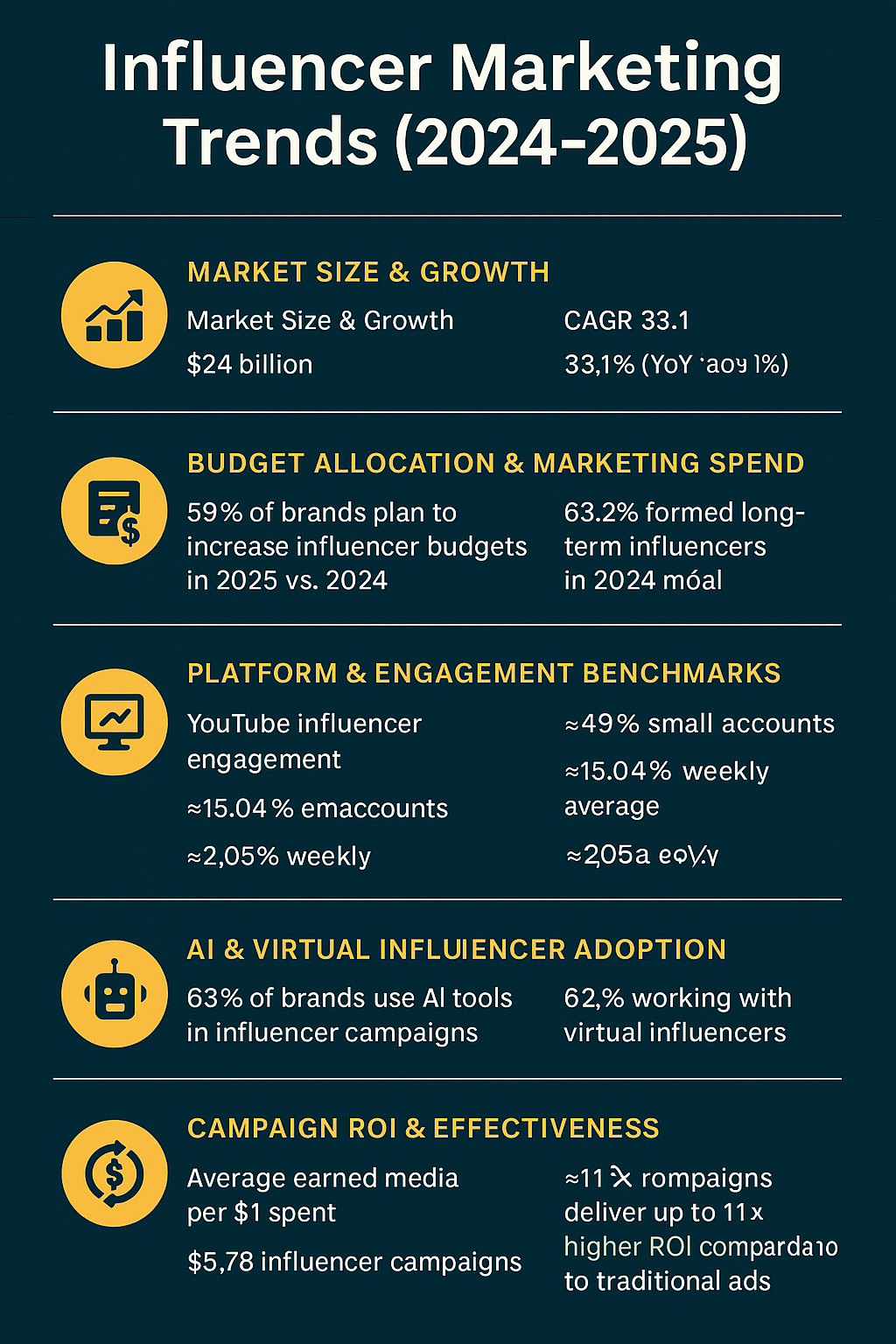
Market Size & Growth
- 2024: $24 billion
- 2025: $32.55 billion (+35.6 % YoY) (Influencer Marketing Hub)
- CAGR (2014–2025): 33.1 % (from $1.4 b in 2014 to $32.55 b in 2025) Influencer Marketing Hub
Budget Allocation & Marketing Spend
- Brands increasing influencer budgets in 2025: 59 % plan to partner with more influencers vs. 2024 (Marketing Dive)
- Brands forming long-term influencer relationships: 63.2 % maintained creator relationships across different campaigns in 2024 (Digital Marketing Institute)
- Brands allocating >40 % of marketing budget to influencer marketing: 26 % globally in early 2024 (Sprout Social)
Platform & Engagement Benchmarks
- YouTube influencer engagement: ~49 % (likes, comments, shares), highest among channels (Dash App)
- TikTok small-account engagement: ~15.04 % (nano/micro influencers)
- YouTube engagement average: ~3.47 % (macro/mega creators)
- Instagram average: ~2.05 % weekly engagement (Clear Voice)
AI & Virtual Influencer Adoption
- Use of AI tools in influencer campaigns: 63 % of brands planned to use AI in 2024 (nypost.com)
- Brands working with virtual influencers in 2024: 62.2 % (up from 60.4 % in 2023) ClearVoice
Campaign ROI & Effectiveness
- Average earned media return per $1 spent: $5.78 EMV (Convince & Convert / IMH) ClearVoice
- ROI comparison: Influencer campaigns deliver up to 11× higher ROI than traditional ads Influencer Marketing Hub
Key Insights (Trends Overview)
| Trend Category | Key Insight (2024 → 2025) |
| Market Expansion | Market grew 35.6 % to $32.55b; influencer marketing becomes a core pillar in digital budgets. |
| Budget Shift | Majority of brands (59 %) increased influencer investments; 26 % now devote over 40 % of budgets. |
| Platform Engagement | YouTube leads in engagement (~49 %); TikTok small creators outperform on niche interaction. |
| Strategic Partnerships | 63 % of brands retain influencers across multiple campaigns; long-term relationships prioritized. |
| AI & Virtual Influence | 63 % use AI tools; 62.2 % collaborate with virtual influencers—rising technology-led evolution. |
| ROI & EMV | $5.78 EMV per $1 spent; ROI up to 11× that of traditional advertising formats. |
Conclusion: Influence Is Currency
Here’s the truth: consumers don’t want ads. They want authenticity. They crave connection. And they respond to trust—not targeting.
That’s why influencer marketing works. It bridges the gap between brand and buyer using the most powerful force in digital culture: people.
Whether you’re a startup founder trying to get eyes on your product, or a CMO looking to scale your reach without wasting ad spend, influencer marketing is no longer a nice-to-have—it’s a growth engine.
But the real winners? They’re not chasing followers. They’re building ecosystems. They know how to:
- Partner with the right creators
- Set clear goals and measurable KPIs
- Tell stories that resonate
- And most importantly… deliver value on both sides of the collab
So, what is influencer marketing in 2025?
It’s not just a strategy.
It’s the future of trust in digital commerce.
Frequently Asked Questions: What is Influencer Marketing?
What is influencer marketing in simple terms?
Influencer marketing is when brands partner with trusted social media creators to promote products or services to a targeted audience.
Why is influencer marketing so effective?
Because people trust recommendations from influencers more than traditional ads—boosting authenticity, engagement, and conversions.
How much do brands typically spend on influencer marketing?
According to Influencer Marketing Hub (2025), brands spend between $1,000 to $1M+ per campaign depending on reach and niche.
What platforms are best for influencer marketing in 2025?
Instagram, TikTok, YouTube, and LinkedIn lead the way for engagement. TikTok is dominating short-form influence, especially for Gen Z.
How do I measure influencer marketing ROI?
Track engagement rate, click-throughs, reach, sales conversions, and creator-specific UTM links for campaign-level insight.
References
- Influencer Marketing Usage (2025)
“93% of marketers now use influencer marketing.”
Influencer Marketing Hub – Benchmark Report 2025 - Influencer ROI vs Traditional Ads
“Influencer campaigns are expected to deliver 11x higher ROI compared to traditional digital ads.”
Shopify – Influencer Marketing Statistics
Influencer Marketing Hub – ROI Report - Social Proof and Purchase Decisions
“49% of consumers rely on influencer recommendations.”
Digital Marketing Institute – Influencer Trust Study - Micro-Influencer Engagement Rates
Micro-influencers see up to 60% more engagement than macro-influencers. - Instagram Remains #1 for Influencer Collabs
“72% of marketers use Instagram for influencer campaigns.”
Statista – Leading Social Platforms for Influencer Marketing - Average Influencer Campaign ROI
“The average earned media value per $1 spent is $5.78.”
Influencer Marketing Hub – ROI Stats - AI in Influencer Discovery (2025)
“More than 60% of brands now use AI to identify influencers.”
HubSpot – The State of Marketing AI Report


